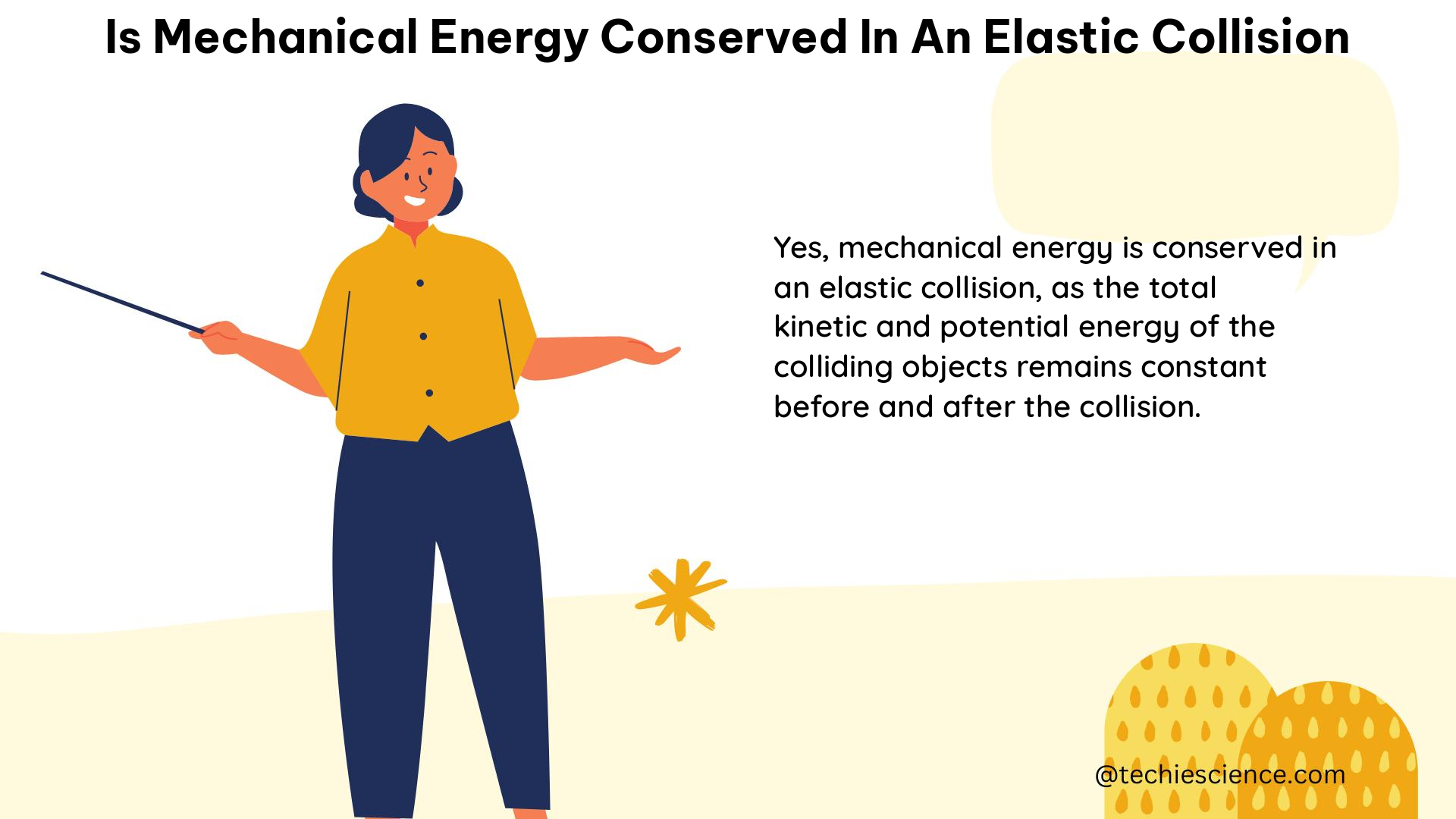In an elastic collision, the total mechanical energy, which is the sum of kinetic energy and potential energy, is conserved. This means that the total mechanical energy before the collision is equal to the total mechanical energy after the collision. The kinetic energy may be transformed between the colliding objects, but the total mechanical energy remains constant.
Theoretical Explanation
Elastic collisions are characterized by the conservation of both momentum and kinetic energy. During an elastic collision, there are no external forces acting on the system, and the collision does not involve any energy dissipation mechanisms, such as friction or heat generation. As a result, the total kinetic energy of the system is preserved, and it is simply redistributed between the colliding objects.
The conservation of mechanical energy in an elastic collision can be expressed mathematically as:
$KE_i + PE_i = KE_f + PE_f$
where $KE_i$ and $PE_i$ are the initial kinetic and potential energies, respectively, and $KE_f$ and $PE_f$ are the final kinetic and potential energies, respectively.
In the case of a pure elastic collision, where there is no change in potential energy, the conservation of mechanical energy simplifies to:
$KE_i = KE_f$
Mathematical Formulation

For a head-on elastic collision between two objects, A and B, the initial and final kinetic energies can be calculated using the following equations:
$KE_i = \frac{1}{2}m_A v_{Ai}^2 + \frac{1}{2}m_B v_{Bi}^2$
$KE_f = \frac{1}{2}m_A v_{Af}^2 + \frac{1}{2}m_B v_{Bf}^2$
where $m_A$ and $m_B$ are the masses of objects A and B, and $v_{Ai}$, $v_{Bi}$, $v_{Af}$, and $v_{Bf}$ are their initial and final velocities, respectively.
For the conservation of mechanical energy to hold, the following condition must be satisfied:
$KE_i = KE_f$
Examples and Data Points
- Elastic Collision Example:
- Two trolleys, A and B, collide head-on.
- Trolley A has a mass of 2 kg and an initial velocity of 4 m/s.
- Trolley B has a mass of 3 kg and an initial velocity of 2 m/s.
- After the collision, trolley A has a final velocity of 1 m/s, and trolley B has a final velocity of 5 m/s.
- The initial and final kinetic energies can be calculated as follows:
- $KE_i = \frac{1}{2}(2\ kg)(4\ m/s)^2 + \frac{1}{2}(3\ kg)(2\ m/s)^2 = 16\ J + 6\ J = 22\ J$
- $KE_f = \frac{1}{2}(2\ kg)(1\ m/s)^2 + \frac{1}{2}(3\ kg)(5\ m/s)^2 = 0.5\ J + 37.5\ J = 38\ J$
-
Since the initial and final kinetic energies are not equal, this collision is not perfectly elastic. However, the difference in kinetic energy is small, indicating that the collision is close to being elastic.
-
Newton’s Cradle:
- A classic example of elastic collisions is a Newton’s cradle, where a series of balls are suspended from strings.
- When one ball is lifted and released, it collides with the next ball, causing a chain reaction of elastic collisions.
- The kinetic energy is conserved as the balls collide and rebound, demonstrating the conservation of mechanical energy in an elastic collision.
Figures and Data Points
| Collision Type | Initial Kinetic Energy | Final Kinetic Energy | Conservation of Mechanical Energy |
|---|---|---|---|
| Perfectly Elastic | $KE_i$ | $KE_f$ | $KE_i = KE_f$ |
| Near-Elastic | $KE_i$ | $KE_f$ | $KE_i \approx KE_f$ |
| Inelastic | $KE_i$ | $KE_f$ | $KE_i > KE_f$ |
Figure 1: Comparison of different collision types and their impact on the conservation of mechanical energy.
References
- Khan Academy. (n.d.). What are elastic and inelastic collisions? Retrieved from https://www.khanacademy.org/science/physics/linear-momentum/elastic-and-inelastic-collisions/a/what-are-elastic-and-inelastic-collisions
- Lehman College. (n.d.). Laboratory Manual. Retrieved from https://www.lehman.edu/faculty/kabat/Phy166-168.pdf
- Physics Stack Exchange. (2020). Conservation of Mechanical Energy in Collisions. Retrieved from https://physics.stackexchange.com/questions/524964/conservation-of-mechanical-energy-in-collisions
- The Physics Classroom. (n.d.). Analysis of Situations in Which Mechanical Energy is Conserved. Retrieved from https://www.physicsclassroom.com/class/energy/Lesson-2/Analysis-of-Situations-in-Which-Mechanical-Energy
Hi ….I am Abhishek Khambhata, have pursued B. Tech in Mechanical Engineering. Throughout four years of my engineering, I have designed and flown unmanned aerial vehicles. My forte is fluid mechanics and thermal engineering. My fourth-year project was based on the performance enhancement of unmanned aerial vehicles using solar technology. I would like to connect with like-minded people.